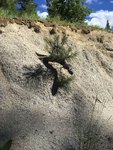Mihai
Shohin
Hello nuts. Need some advice about yamadori pine collection. Has anyone succesfully collected from super sandy/clay soil?
I found a drop dead gorgeous patch of pine trees. They are all over 60-70 years old with amazing mature bark and a lot of trunk movement. Stunted in growth. Problem is that they are located on the side of an artificial hill made as a side efect of a caolin mining operation. So basically the whole hill is super sandy clay and none of these trees have a rootball. They have super long finger-thick roots going of in all directions and no feeders close to the trunk?
Anyone have a clue as to how one might approach collecting something like this?
I found a drop dead gorgeous patch of pine trees. They are all over 60-70 years old with amazing mature bark and a lot of trunk movement. Stunted in growth. Problem is that they are located on the side of an artificial hill made as a side efect of a caolin mining operation. So basically the whole hill is super sandy clay and none of these trees have a rootball. They have super long finger-thick roots going of in all directions and no feeders close to the trunk?
Anyone have a clue as to how one might approach collecting something like this?
Last edited:


